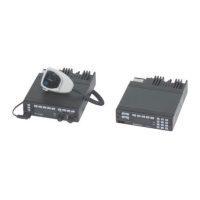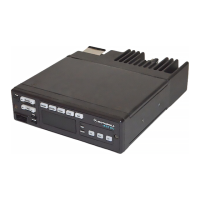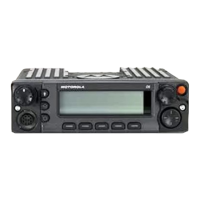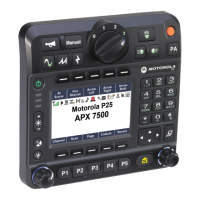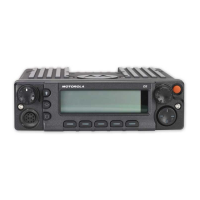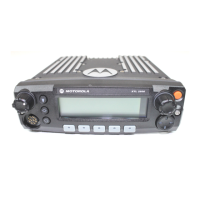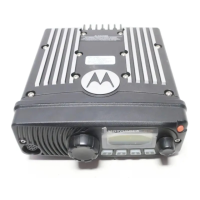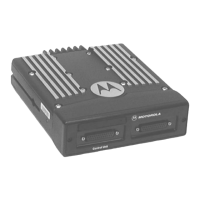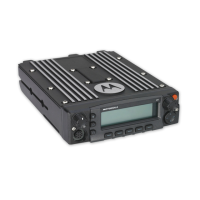Theory of Operation: Tone Remote Control Board
6881086C22-B 27
The input from the phone line is applied to U112 op amp 1 pin 2, along with the
line driver audio-canceling voltage (described previously) via S101-7 and
S101-8. The gain of U112 op amp 1 is controlled by FET transistor Q113. The
lower the DC gate voltage on Q113, the higher the gain, since a more negative
gate voltage tends to turn off the FET, creating maximum feedback resistance
across pins 1 and 2 of U112 op amp 1. The AGC potentiometer (R529) sets the
maximum gain point of the AGC. Normally, the potentiometer setting allows
input signals as low as –35 dBm to achieve full deviation. After the AGC circuit,
the audio is amplified by a factor of 20 (U112 op amp 4) and is sent to the
transmit guard-tone notch filter (HY2 filter 2).
The transmit guard-tone notch filter is formed by summing the two outputs of
the hybrid in the same manner as the receive notch filter previously discussed.
This filter notches out the guard-tone frequency area of the voice spectrum
before sending the audio to the radio to be transmitted. The notch filter's high
“Q” of 5.8 ensures removal of the guard-tone frequency component without
affecting the adjacent voice energy in the audio signal being transmitted.
The filtered audio level is adjusted by potentiometer R569 to set the
transmitted deviation. The audio is routed through buffer amplifier U105 op
amp 4 and then (via TX_AUDIO) into amplifier U110 op amp 1, after which it is
sent to the ASTRO transceiver to be transmitted. The audio is also passed to
buffer amplifier U106 op amp 2. The output of this buffer drives the TAPE OUT
line, which is used for external recording purposes.
The filtered audio is also passed to amplifier U106 op amp 1, whose gain is set
by digital potentiometer U107. The audio is passed to the AUX_RX_AUD input
of the radio, where it is then output to the local speaker.
Audio tones associated with trunking operation are generated locally on the
TRC board. They originate from the microprocessor (U132 pin 38) and are
filtered by low-pass filter U106 op amp 3. The filtered tones are then sent to
buffer amplifier U105 op amp 3 to be sent down the wireline to the remote
speaker.
Local microphone audio (MIC_AUDIO) is passed to buffer amplifier U105 op
amp 2. It is then sent down the wireline allowing local transmit audio to be
monitored at the remote unit. If it is desired to prevent local audio (audio not
received by the radio) from being routed to the remote speaker via the wireline,
place S100-2 to the ON position. This will cause microprocessor U123 pin 35
(WL MUTE) to be asserted, opening the wireline path at U114 gate 2 for local
microphone audio, local trunking tones, and locally generated beeps. Local
microphone audio is also passed through buffer amplifier U105 op amp 1 to
TX_AUDIO to the transmitter
Tone Processing Section Inputs to this section originate from TP1 (the output of U112 op amp 4) in the
wireline transmit audio path. When looking for guard tone (standby operation),
the audio is selected by U114 gate 1 to be routed through the guard tone
bandpass filter and then sent to the filter/limiter. After high-level guard tone
(HLGT) has been detected, U114 gate 1 is toggled to allow audio to bypass the
bandpass filter. This permits unfiltered audio to be decoded and allows for
proper identification of the function tones.
The limiter consists of a gain stage (U112 op amp 3), which also provides some
broadband filtering, followed by a limiter stage that converts the signal to a
square wave. The output of U112 op amp 2 drives transistor Q116. This
transistor provides an input to the microprocessor's Input Capture (U123

